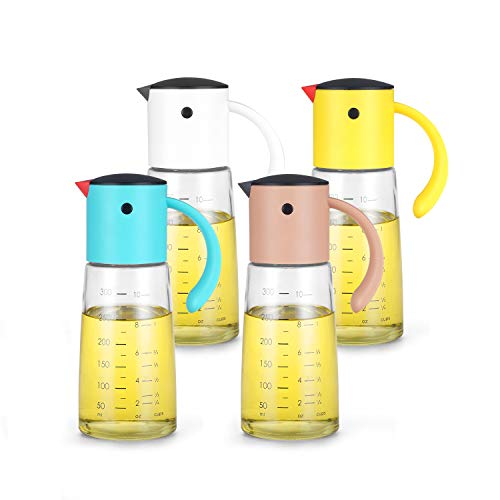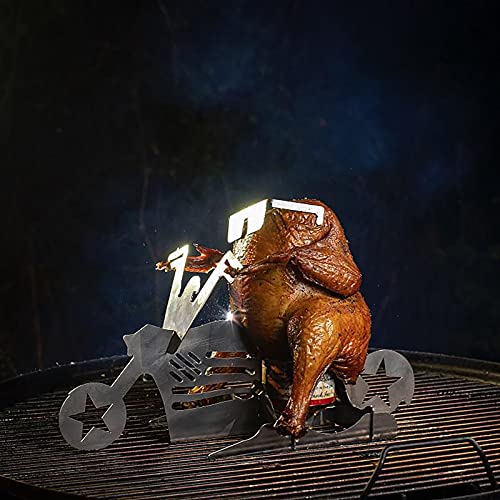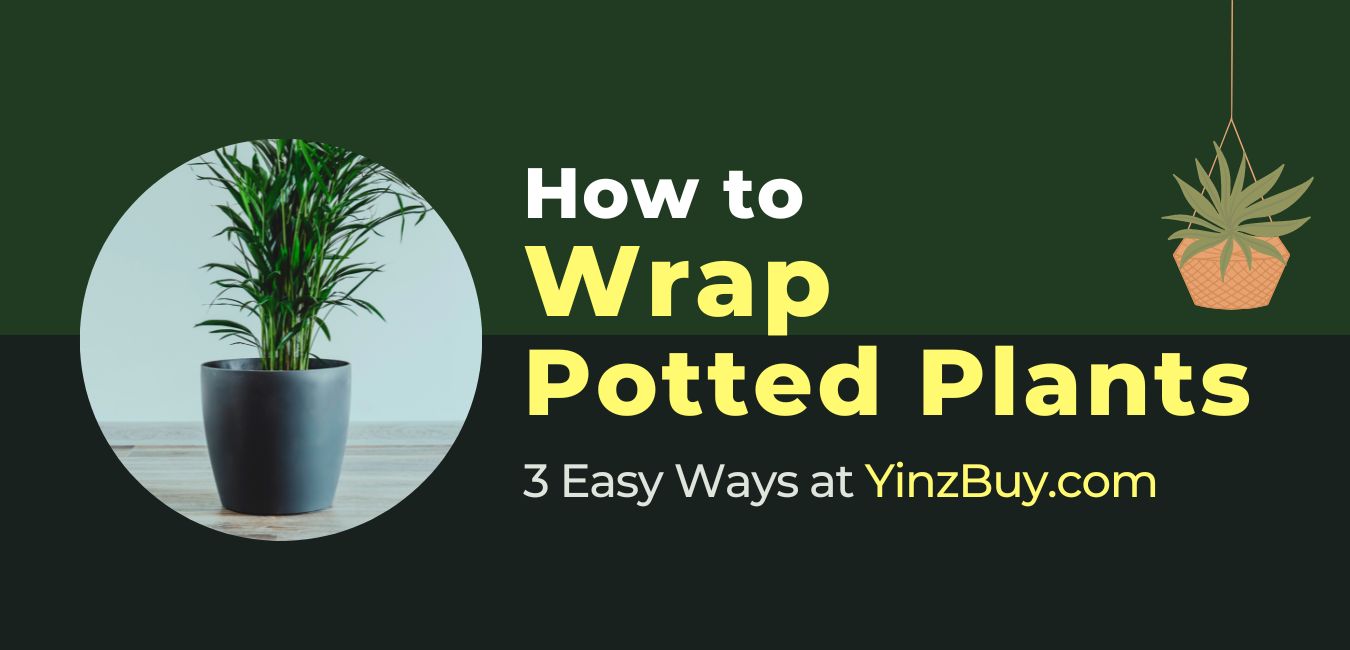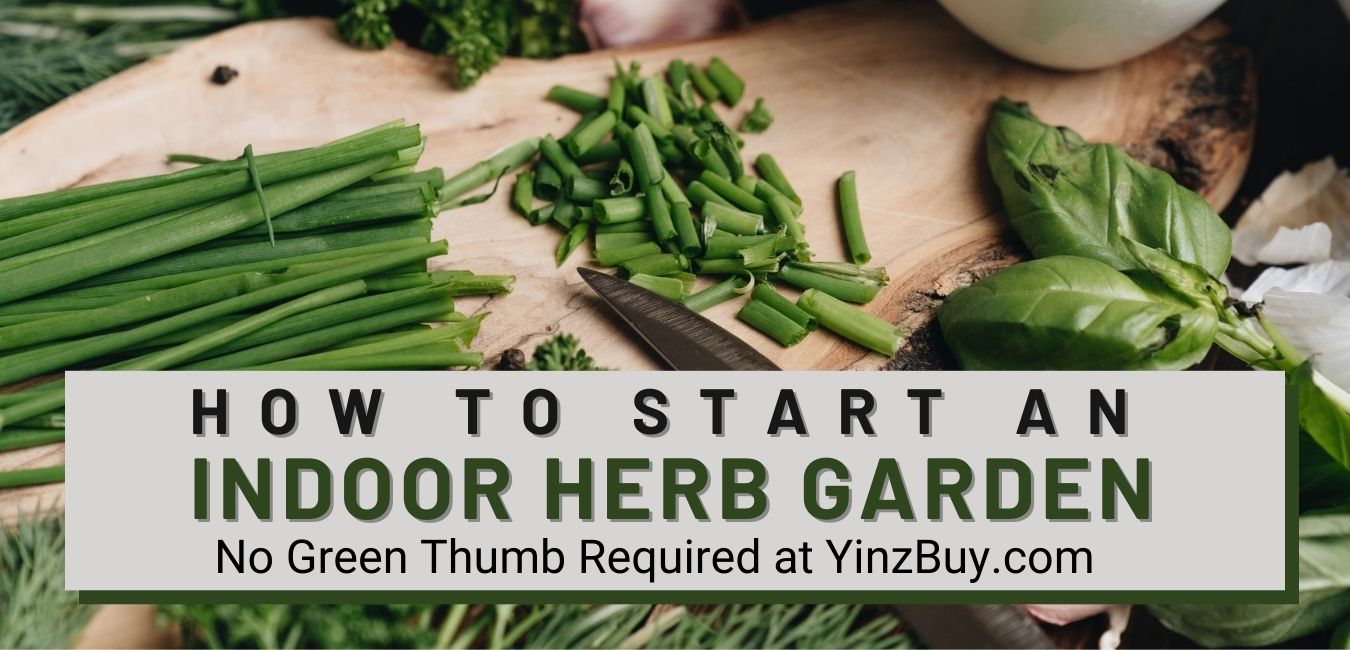
[vc_row equal_height=”yes”][vc_column][vc_row_inner][vc_column_inner width=”1/6″][vc_facebook type=”button_count”][/vc_column_inner][vc_column_inner width=”1/6″][vc_tweetmeme share_via=”YinzBuy”][/vc_column_inner][vc_column_inner width=”1/6″ css=”.vc_custom_1606731333432{margin-top: -5px !important;}”][vc_pinterest][/vc_column_inner][vc_column_inner width=”1/2″][/vc_column_inner][/vc_row_inner][vc_row_inner][vc_column_inner][vc_column_text]You can enjoy the benefits of an indoor herb garden even if you don’t have a green thumb. A lack of plant knowledge or previous plant parenting failures shouldn’t stop you from starting an indoor herb garden. They’re a great source of flavors for cooking, are pretty to look at, smell great, and they clean the air too!
As a general rule, sunlight, potting soil, water, and a small area of space are all you need to start an indoor herb garden. Knowing which herbs are best for indoor herb gardening will also make your journey in indoor herb gardening a successful one.
You can enjoy gardening on a small scale, even without a big backyard. Many herbs can be grown indoors, and you can reap the benefits of indoor gardening during all seasons. Keep reading to find out all the things you will need to start your indoor herb garden.[/vc_column_text][vc_column_text]
[/vc_column_text][vc_column_text]
The Essentials of Growing an Indoor Herb Garden
Before you commit to your indoor herb garden, there are some must-have supplies and things to consider. Here’s exactly what you’ll need and what you’ll need to think about before getting started:
- An area in your home with ample sunlight. This can be a window sill or a corner of a room, whatever works for you.
- Planting pots or containers. The type and size will depend on the kinds of herbs you want to grow and how much you want to grow.
- Soil mix and fertilizer. This will be strengthening the roots of your herbs and their overall sustenance.
- Seeds or plant sprouts. Planting these will begin your new indoor gardening adventure.
- Some patience and love. Plants are living things, so showing some TLC to your new herbs can make a positive difference.
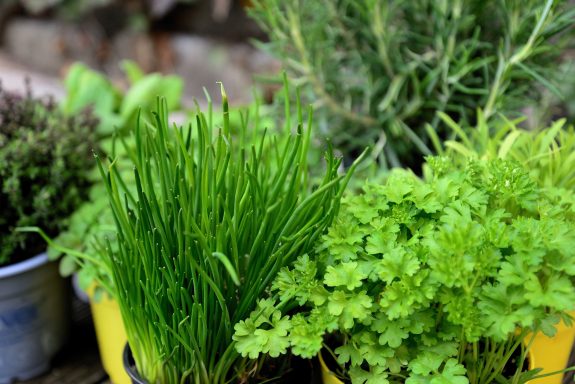 [/vc_column_text][vc_column_text]
[/vc_column_text][vc_column_text]
Gardening Terms to Add to Your Vocabulary
In addition to the supplies and considerations above, these words are helpful to have in your back pocket, too. Understanding the gardening lingo will help make the process of beginning an indoor herb garden easier for you. These terms will also help you when visiting the nursery or greenhouse to choose your plants. Here are the basic gardening terms you should add to your vocabulary:
| Gardening Term | Definition |
| Herbs | Any plants that have seeds, flowers, or leaves that are used for the following purposes: food, flavoring, medicine, or perfume. |
| Germinate | When a seed begins to grow. |
| Propagate | Creation of new plants, whether by seed or stock from a parent plant. |
| Sprout | A small growth on the plant, like a small new bud. |
| Cutting | A section of a plant’s leaf, root, or stem can develop into a new plant. |
| Transplants | A section of a grown plant is cut off and transferred into a new growing medium. |
| Drought-tolerant | Able to survive and grow in conditions with low water. |
| Annuals | Plants that complete their life cycles within one year or less. |
| Biennials | Plants that complete their life cycles within two years. |
| Perennials | Plants that live for two years to several years are called perennial plants. |
[/vc_column_text][vc_column_text]
Choose What You Wish to Grow – Seed or Sprouted Plants
When you begin to grow your herbs indoors, you may choose to grow from seeds or by using already sprouted plants. Here are the main ways seeds vs sprouts differ, to help you decide:
- The sprouted plants, cuttings, and transplants are easier to grow
- Sprouted seeds, cuttings, and transplants have already conquered the first steps to life
- Herb seeds are cheaper, and you’ll end up with more plants
- Seeds require more effort and work for them to grow
- When you’re more confident in indoor gardening, you’ll be able to use seeds from your current plants to sprout new ones
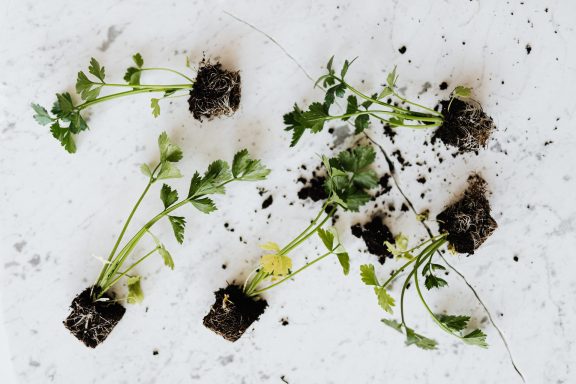 [/vc_column_text][vc_column_text]
[/vc_column_text][vc_column_text]
How to Grow Herb Sprouted Plants or Cuttings
Sprouted plants and cuttings are a great choice for complete beginners. They are already growing, so they automatically have a higher chance than seeds to continue thriving. Here are the basic steps on how to grow sprouted herb plants or cuttings:
-
- Choose your herb cuttings or sprouted herbs. You can gather these herb pieces from a friend’s garden, a neighbor’s garden, or even from the herb sprigs bought from a grocery store.
- Make sure your herb cuttings or sprouted herbs are fresh and healthy. Select cuttings and sprouted plants that appear disease-free.
- Place the herb plant in a glass of water. The water (not soil) will promote the growth of roots. Change the water every day or every two days.
- Once the roots have grown, you can use the leaves and shoots of your herbs. It can take up to a few days to a few weeks for the roots to grow.
- Transplant if desired. Optionally, you can relocate the herbs with the formed roots into a soil-filled pot or container.
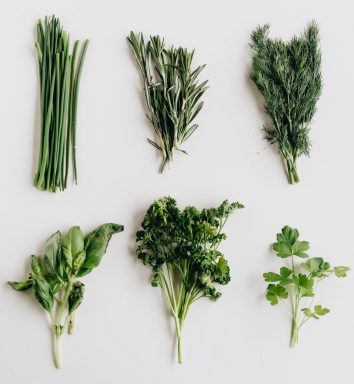 [/vc_column_text][vc_column_text]
[/vc_column_text][vc_column_text]
How to Grow Herb Seeds
Growing a full-plant from their first step in life is truly a rewarding experience. If you’re ready to take the leap, here’s how to grow herb seeds:
-
- Select your herb seeds. You can find herb seeds in grocery stores, farm stores, by mail order, or online.
- Find the spot you want to grow the herb seeds. Choose an area in your home that is clean and has sunlight
- Lightly sow the herb seeds. You want the seeds to be in the soil, but not dug in deep. Follow the planting directions on the packet for distance between seeds. This isn’t required if you’re using starter pots and plan to transfer after sprouting.
- Water the soil regularly to ensure it is evenly moist. Make sure not to overwater and drown them.
- Always make sure to follow any directions. Some varieties may require special considerations. Always check your selection of herb seeds for important notes.
[/vc_column_text][vc_column_text]
How to Cut Herbs to Grow Them
In general, you want to keep things clean when cutting herbs to grow them. Below are the steps you’ll need if you’re cutting herbs for growth:
-
- Use sharp and clean scissors or knives when cutting herbs.
- Wipe the cutting tool with rubbing alcohol before you cut the herbs. The rubbing alcohol will prevent the knife or scissors from introducing potential diseases to the herbs. Alternatively, you can wash thoroughly in soap and hot water before cutting the herbs.
- Make sure your tools are completely dry before you cut the herbs.
- Always choose fresh, green, and healthy-looking herbs before you cut them.
- Cut only about one-third of the chosen herb plant. The idea with a cutting is to leave the rest of the plant intact and able to continue growing.
- If there are any flowers on your herbs, pinch the flowers off before transplanting them. You don’t want flowers when you start to grow because that will prevent proper root formations.
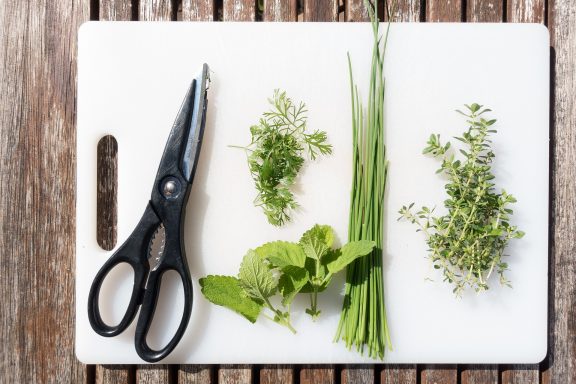 [/vc_column_text][vc_column_text]
[/vc_column_text][vc_column_text]
Types of Plant Containers to Use
Herbs are wonderful because they can grow in the ground and pots. For indoor gardening, you can choose a pot or a container. Here are a few things for you to keep in mind before you plant your herbs:
- Drainage is key. Excess water should be able to seep out easily. The container or pot should have at least one hole at the bottom. Place a saucer, liner, or pan underneath to collect water that leaks out.
- Material of pots and containers matters. Clay pots are good for drainage, but also dry the soil out faster. They’re a good choice in colder or more humid locations. Glazed or plastic pots retain moisture better. Choose them for drier climates.
- Hanging planters keep pests away. If you’re planting outdoors and concerned about wildlife, consider a hanging planter. It functions just as well for growth, but keeps the plants out of reach for deer snacks.
- Grab a glass for cuttings. Unlike seeds or transplants, cuttings should be started in water. Choose a clean glass cup or jar to get them going. Using dark or amber colored glass will help prevent algae growth in the water.
- Use a starter container for seeds and seedlings. Choose a seed starting tray to give your plants a place to germinate. In a pinch, you can even use a paper cup half filled with potting soil. Make sure to punch a hole in the bottom for drainage. Once your seeds sprout, they can be transferred to larger pots.
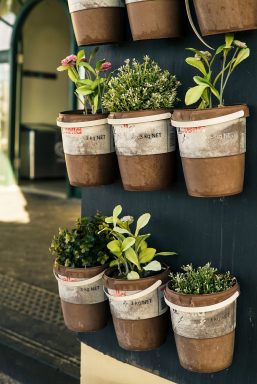 [/vc_column_text][vc_column_text]
[/vc_column_text][vc_column_text]
Making a One Pot Herb Garden
Using one large container instead of multiple small pots to grow all your herbs saves space and looks great too. Here is how to maintain a one pot herb garden inside:
- Choose the correct size. It is important you find a container that is big enough for all the herb plants you plan on growing. Choose which varieties and quantities you’d like to grow. Factor in how far apart the plants need to be as well. For example, three plants that need 12” spacing will need a container at least 24” wide.
- Check the depth. Not only does width matter, but depth does as well. This will affect the amount of soil your container can hold. Most herbs need around one gallon of soil per plant. There are some exceptions, so make sure to check the specifics on your desired herbs.
- Make sure it has drainage. Just like smaller pots, single one pot herb containers must have holes at the bottom for drainage. Drainage is very important for healthy plant growth. Excess water will rot the plants’ roots and damage the overall plants.
- Find the right location. Place the container in an ideal location where it can stay put. It should be a clean, well-lit area of your home. Once filled, a container gets heavy, making moving it a hassle. Use a plant shelving system to help organize and raise pots closer to a window.
- Make some labels. Add nursery tags to every new plant when you plant them. Herbs and plants tend to look very similar, so you don’t want to deal with confusion later on. Nothing quite ruins a meal like accidentally adding the wrong herbs! Mint instead of cilantro? No thanks!
[/vc_column_text][vc_column_text]
Pick the Appropriate Soil and Fertilizer
Potting mix and potting soil are the types of soils you will need to grow herbs indoors. If you are wondering if there is a difference between the two, the answer is yes!
| Potting mix | Potting soil |
| Mixes have no soil or unnecessary dirt in them. | Potting soil contains both soil and dirt. |
| Mix has all the right ingredients in the correct amounts to maximize the growth of plants. The potting mix also allows better aeration. | Soils are made specifically for plants that will grow in pots and containers. |
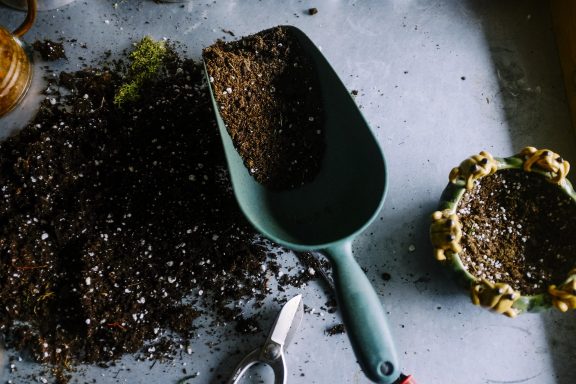
Both potting mix and potting soils are made specifically for plants that will grow in pots and containers, hence they both have potting in their names. Unlike the ground outdoors, a pot or container can block the water drainage and limit the root growth space. Potting soil and potting mix help prevent these two issues.
You can use either potting mix or potting soil to start your indoor herb garden, or a combination of both. If you have to choose, the potting soil is slightly more preferable. Avoid using garden soil or black earth, as they can be too heavy for the roots of the herb to grow and spread properly.[/vc_column_text][vc_column_text]
How to Fill your Pot or Container with Soil and Fertilizer
Here are some fairly simple steps for you to fill your container or pot properly with soil:
-
- Fill the bottom of the pot or container with stones or gravel. Create a layer about 3 inches deep. This will help the drainage system of the container.
- Add your potting mix or potting soil. Fill it up until there is about three inches of space from the top of the pot to the soil.
- Water the soil lightly and evenly. Use a hose or faucet with a light spray function if possible. Mix the soil with the water until the soil is moist and muddy throughout. Remember, the soil should not be drenched. This slight amount of water is what will activate the soil.
- Add your seed or transplant. Cover the seed with soil at the depth indicated on the package. If transplanting, cover the roots entirely leaving the stem and leaves exposed.
- Finish it off with plant food. You can use any basic houseplant fertilizer, but an herb specific variety is best. Two main types, loose and spikes are available. If you lack pot space to mix in more loose dirt, spikes are the ideal choice. Choose fertilizers that are slow releasing, as they are better for the growth and sustenance of herbs.
[/vc_column_text][vc_column_text]
Find the Appropriate Lighting for your Indoor Herb Garden
Sunlight is essential for growing herbs or any plants. Most varieties require six to eight hours of sunlight each day to survive and grow. Here’s how to find appropriate lighting to make your indoor herb garden thrive:
-
- Place your indoor herb garden by a window. If you’re using a small pot or container, or multiple small ones, you can keep it on the window sill. Make sure you have drip trays so as to not damage the sill.
- Choose a sunny window. Make sure the window you place your herb garden by has a lot of sunlight pouring through it on a regular sunny day. Avoid shady porches or partially obstructed windows.
- Use a porch. Sunrooms and enclosed porches are a great placement choice, as they’re often designed to receive a lot of light. Even covered exterior porches will work, as long as you move your plant indoors as needed. Inclement weather, especially the cold, is hard on plants.
- Add curtains if needed. If your windows get too much sun, adding curtains or blinds will help. They allow you to better control how much sunlight your indoor herb garden gets.
- Supplement with artificial light. If the weather isn’t giving off enough natural light, add in a full spectrum lamp to help. A clip on style can attach to a table or windowsill and be directed over the plants.
[/vc_column_text][vc_column_text]
Which Herbs Grow Best Indoors?
If you’re new to indoor gardening, choosing an herb that does well in that environment will be helpful. These are plants that grow well in containers, enjoy stable temperatures, and do well with limited maintenance. Just water, fertilize, and give them plenty of light for success. Here are some herbs which grow best indoors:
| Herb | Pot Size Needed | Time to Mature | Grow Cycle |
| Basil | 4-6”W x 8-10”H | 3-4 weeks | Annual |
| Thyme | 4-6”W x 4”H | 8 weeks | Perennial |
| Lemongrass | 12”W x 8”H | 4-8 months | Perennial |
| Chives | 6-8”W x 6”H | 6 months | Perennial |
| Parsley | 6-8”W x 8-10”H | 2-3 months | Biennial |
| Coriander (Cilantro) | 8”W x 8-10”H | 1.5-2.5 months | Annual |
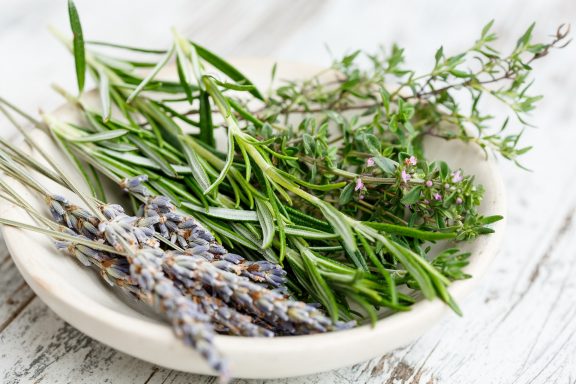 [/vc_column_text][vc_column_text]
[/vc_column_text][vc_column_text]
Which Herbs are the Easiest to Grow?
Along with the herbs mentioned above, there are more herbs that are easy to grow and fairly low maintenance. These herbs would be great for your indoor garden if you are a busy person, or simply don’t want the hassle of extra gardening responsibility.
- Rosemary
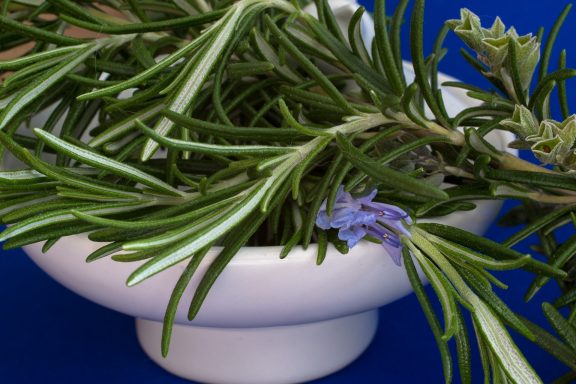
Why it’s easy: Rosemary propagates and grows quickly. A cutting will develop roots in about 4-8 weeks and can be transplanted to soil. It enjoys full sun, particularly from a south-facing window.
What it’s used for: Most commonly found in cooking, Rosemary seasons soups, stews, and casseroles. It can be used in salad dressing, or to top a loaf of baking bread. It’s also often a seasoning for proteins, with chicken or fish being most prevalent.
- Oregano
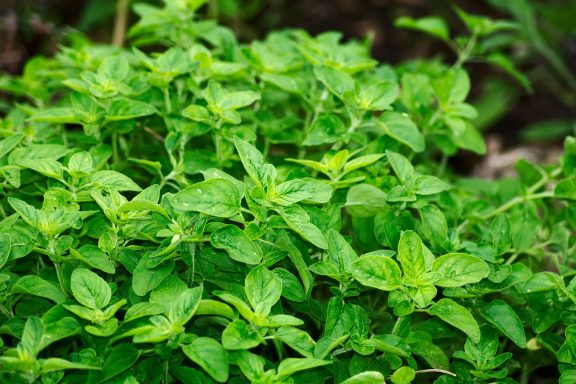
Why it’s easy: Oregano is a low maintenance and versatile plant. It requires regular watering and about six hours of sunlight a day to be happy.
What it’s used for: Also most used in cooking, Oregano is a staple Italian herb. You’ll find it in pizza, pasta, and sauce recipes. It’s also a great seasoning for vegetables and proteins, particularly when broiled or grilled. It keeps its potency well when dried, so excess harvest can be stored for later use.
- Mint
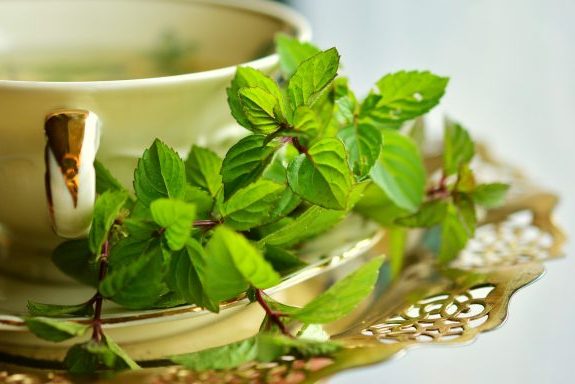
Why it’s easy: Mint likes to be kept in a moist container and does best supplemented with water soluble plant food. It’s incredibly hardy and propagates readily.
What it’s used for: Mint is an aesthetic and pleasantly scented houseplant, aside from being edible. It’s often used in cocktails, as flavoring in ice cream, or as a garnish. It’s also often used in creating scented oils for use in perfume, soaps, and more.[/vc_column_text][vc_column_text]
Post Planting – How to Take Care of Your Indoor Herb Garden
Once you have prepared the pot and soil and planted your herbs, you have done most of the hard work. However, it’s important to maintain consistent, ongoing care to ensure healthy grown herbs.
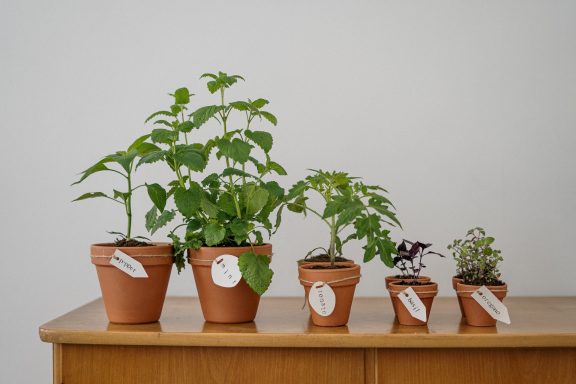
Here are some watering tips and tricks to keep in mind while caring for your indoor herb garden:
-
- Water your herb plants often. This is especially important when they are seeds, just sprouted, or newly planted.
- Visually inspect the soil. The rule of thumb is that the soil should appear very moist on day one and slightly moist on day two, then repeat. Herb plants need plenty of water, but of course, too much water is never a good thing either.
- Maintain a watering pattern. Once the herb plants begin to reach maturity, you should give them around one inch of water per week. This can vary slightly, so be sure to check the individual water needs of your specific herb.
- Make a plan when you’re away. If you’re away from home, your plants will still need care. Make sure to arrange for a neighbor to water them while you’re gone. If that isn’t possible, use a self watering bulb to keep your plants hydrated for longer.
Tip! New gardeners often make the mistake of watering too little or too much. Try this trick to know if the soil is moist enough. Stick your finger into the soil. If it easily goes down to the knuckle, then the soil is too dry.
[/vc_column_text][vc_column_text]
Final Thoughts
Beginners and advanced gardeners alike can benefit from an indoor herb garden. You’ll be rewarded with fresh herbs that you can eat and enjoy. The plants will also add a touch of greenery to your home. Whether you garden as a hobby, to relieve stress and focus, or just for food, an herb garden is a great choice!
Happy gardening![/vc_column_text][vc_column_text]
As noted on our Affiliate Disclaimer page, links to products inside this blog could lead to sales commissions (at no additional cost to you) which allow this site to continue operations.
[/vc_column_text][/vc_column_inner][/vc_row_inner][/vc_column][/vc_row]

